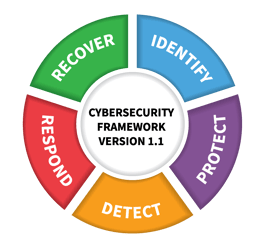As cybersecurity risks continually increase, businesses must strengthen the resilience of their organization by maintaining a consistent approach to identifying and managing their cybersecurity risk. The key goal of a cybersecurity framework is to improve an organization’s cybersecurity and resilience by helping to reduce and better manage cyber risks.
Risk management is the set of steps an organization takes to identify, assess, and manage cybersecurity risk. The first step of risk management is to understand the potential risks your business faces and the likelihood that they occur. Once you have a clear understanding of your risks, you must determine your risk tolerance, or the acceptable level of risk your organization is willing to take to achieve your business objectives.
5 Core Elements of a Cybersecurity Framework
The core elements of a cybersecurity framework consist of 5 functions to help organizations better manage cybersecurity risks:

- Identify – To manage cybersecurity risk, it’s essential to assess your organization’s systems, assets, people, data, and capabilities. This function is the foundation of your cybersecurity framework by defining what key processes and assets need to be protected.
- Protect – Your organization should implement appropriate safeguards to ensure your business is protected and will remain operational in the case of an event. This function includes security awareness training for all employees to reduce the risk of unauthorized access to your company’s systems.
- Detect – Detecting potential cyber threats will allow your organization to respond fast. Continuous monitoring of all networks and systems is essential to uncover threats lurking in your environment. Your organization should implement appropriate mechanisms to identify an incident when it occurs.
- Respond – Your organization should have processes in place to contain the impact of a cybersecurity incident in the case that it occurs.
- Recover – This function focuses on implementing processes that will restore any services or capabilities that were compromised during an event. Disaster recovery and business continuity fall under this function to ensure your business remains resilient.
Every organization faces different threats and vulnerabilities, therefore your approach to managing risk should be unique to your business.
Contact us to learn more about how our cybersecurity and risk management platform works to increase your resilience against cyber threats. We defend against cyberattacks with proactive, innovative, and industry-relevant threat intelligence to give you the confidence that comes from knowing your business is always secure. Anytime. Anywhere.
Read Next: Cybersecurity Risks are Heightening in the Financial Industry


